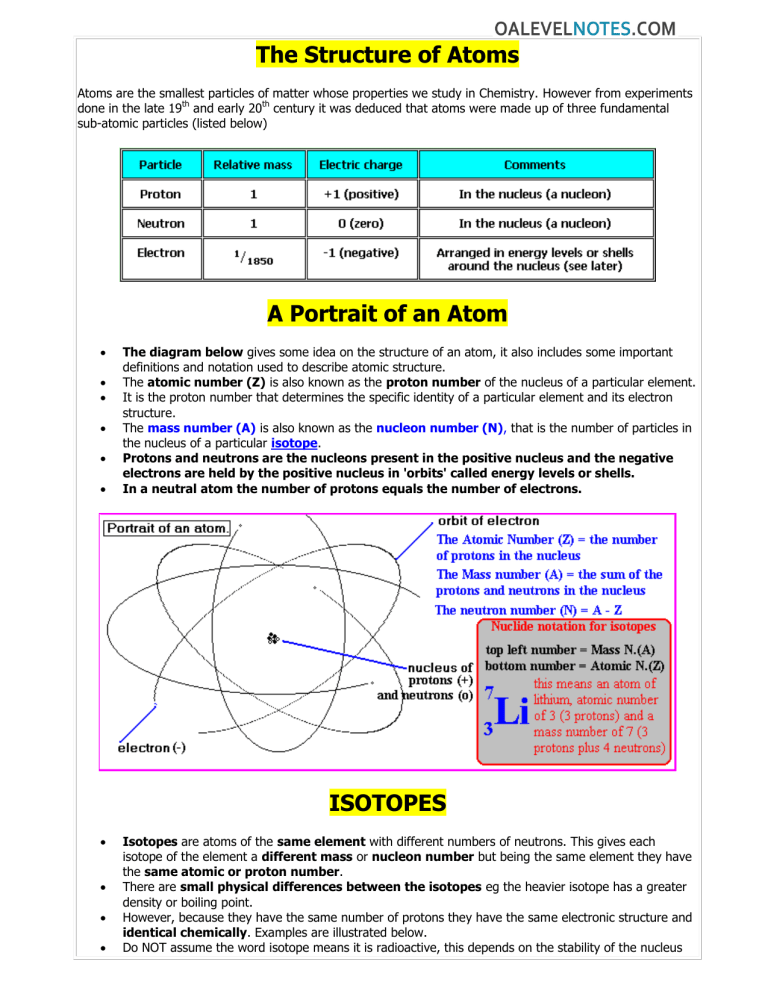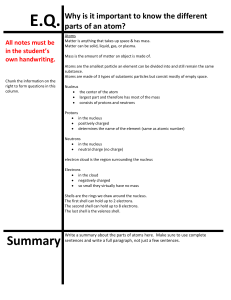Atomic Structure: Subatomic Particles, Isotopes, Electronic Config
advertisement

The Structure of Atoms Atoms are the smallest particles of matter whose properties we study in Chemistry. However from experiments done in the late 19th and early 20th century it was deduced that atoms were made up of three fundamental sub-atomic particles (listed below) A Portrait of an Atom The diagram below gives some idea on the structure of an atom, it also includes some important definitions and notation used to describe atomic structure. The atomic number (Z) is also known as the proton number of the nucleus of a particular element. It is the proton number that determines the specific identity of a particular element and its electron structure. The mass number (A) is also known as the nucleon number (N), that is the number of particles in the nucleus of a particular isotope. Protons and neutrons are the nucleons present in the positive nucleus and the negative electrons are held by the positive nucleus in 'orbits' called energy levels or shells. In a neutral atom the number of protons equals the number of electrons. ISOTOPES Isotopes are atoms of the same element with different numbers of neutrons. This gives each isotope of the element a different mass or nucleon number but being the same element they have the same atomic or proton number. There are small physical differences between the isotopes eg the heavier isotope has a greater density or boiling point. However, because they have the same number of protons they have the same electronic structure and identical chemically. Examples are illustrated below. Do NOT assume the word isotope means it is radioactive, this depends on the stability of the nucleus i.e. unstable atoms (radioactive) might be referred to as radioisotopes. Many isotopes are stable and NOT radioactive i.e. most of the atoms that make up you and the world around you! , and are the three isotopes of hydrogen with mass numbers of 1, 2 and 3, with 0, 1 and 2 neutrons respectively, but all have 1 proton. Hydrogen-1 is the most common, there is a trace of hydrogen-2 naturally but hydrogen-3 is very unstable and is used in atomic fusion weapons. and are the two isotopes of helium with mass numbers of 3 and 4, with 1 and 2 neutrons respectively but both have 2 protons. Helium-3 is formed in the Sun by the initial nuclear fusion process. Helium-4 is also formed in the Sun and as a product of radioactive alpha decay of an unstable nucleus. An alpha particle is a helium nucleus, it picks up two electrons and becomes the atoms of the gas helium. and are the two isotopes of sodium with mass numbers of 23 and 24, with 12 and 13 neutrons respectively but both have 11 protons. Sodium-23 is quite stable e.g. in common salt (NaCl, sodium chloride) but sodium-24 is a radio-isotope and is a gamma emitter used in medicine as a radioactive tracer e.g. to examine organs and the blood system. The relative atomic mass of an element is the average mass of all the isotopes present compared to 1/12th of the mass of carbon-12 atom (12C = 12.00000 ie the standard). The Electronic Structure of Atoms (electron configuration, arrangement in shells or energy levels) The electrons are arranged in energy levels or shells around the nucleus and with increasing distance from the nucleus. Each electron in an atom is in a particular energy level (or shell) and the electrons must occupy the lowest available energy level (or shell) available nearest the nucleus. When the level is full, the next electron(s) go into the next highest level (shell) available. There are rules about the maximum number of electrons allowed in each shell and you have to be able to work out the arrangements for the first 20 elements (see the Periodic Table diagrams further down). st o The 1 shell has a maximum of 2 electrons o The 2nd shell has a maximum of 8 electrons o The 3rd shell has a maximum of 8 electrons th th th o The 19 and 20 electrons go into the 4 shell (limit of GCSE knowledge) If you know the atomic (proton) number, you know it equals the number of electrons in a neutral atom, you then apply the rules to work out the electron arrangement (configuration). Examples: diagram, symbol or name of element (Atomic Number = number of electrons in a neutral atom), shorthand electron arrangement 2 On Period 1 On Period 2 On Period 3 On Period 4 (2 elements only) .... .... .... (3 of the 8 elements) (3 of the 8 elements) ===> Kr [2.8.18.8], The Periodic Table and Electronic Structure Below are the electron arrangements for elements 1 to 20 set out in Periodic Table format (Hydrogen and The Transition metals etc. have been omitted). When you move down to the next period you start to fill in the next shell according to the maximum electrons in a shell rule (see previous section) 3 o o o The first element in a period has one outer electron (eg sodium Na 2.8.1), and the last element has a full outer shell (eg argon Ar 2.8.8) Apart from hydrogen (H, 1) and helium (He, 2) the last electron number is the group number. and the number of shells used is equal to the Period Number. Atomic structure diagrams 4 5



